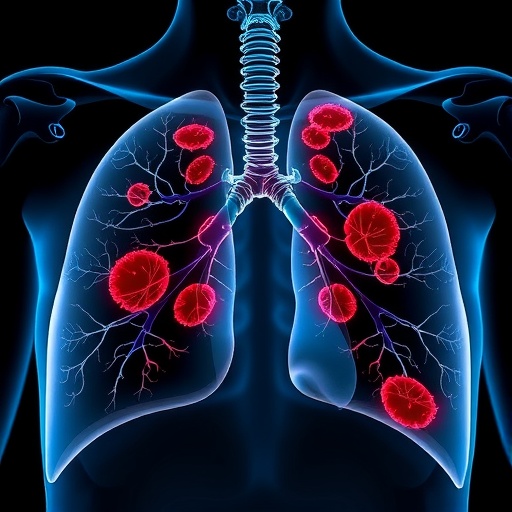
In the ongoing battle between humans and pathogens, understanding the biochemical interplay within infected tissues is paramount. Recent groundbreaking research has shed light on a crucial molecular nexus influencing the progression of respiratory infections caused by the notorious bacterium Staphylococcus aureus. This new study reveals how the regulation of fumarate—a key metabolite—in the airway environment by both the host and the invading pathogen directly influences the severity and development of S. aureus pneumonia. These insights promise to redefine our approaches to tackling severe lung infections that have long challenged clinical management.
Pneumonia, an inflammatory condition of the lung primarily caused by microbial infections, remains one of the leading causes of morbidity and mortality worldwide. Among the repertoire of pathogens capable of inducing pneumonia, Staphylococcus aureus holds a particularly disconcerting position due to its adaptability, virulence, and increasing resistance to antibiotics. Consequently, understanding the biochemical microenvironment that facilitates its colonization and proliferative success in the respiratory tract is critical for developing innovative therapeutic strategies.
The focal point of this research is fumarate, an intermediate metabolite integral to the tricarboxylic acid (TCA) cycle, vital for cellular respiration. Traditionally seen merely as a metabolic substrate in energy production, fumarate’s role has been expanding beyond basic biochemistry to include regulatory functions in host-pathogen interactions. The study meticulously delineates how both host cells and S. aureus manipulate airway fumarate concentrations, orchestrating a biochemical tug-of-war with profound implications for infection dynamics.
.adsslot_f8Qmd5sY6L{width:728px !important;height:90px !important;}
@media(max-width:1199px){ .adsslot_f8Qmd5sY6L{width:468px !important;height:60px !important;}
}
@media(max-width:767px){ .adsslot_f8Qmd5sY6L{width:320px !important;height:50px !important;}
}
ADVERTISEMENT
Host tissues, especially lung epithelial cells, naturally maintain a tightly regulated balance of fumarate within their metabolic milieu. This study reveals that during S. aureus infection, this balance is disrupted in a deliberate manner by both the immune response and bacterial metabolism. The host’s immune cells ramp up fumarate synthesis as an antimicrobial strategy to create a hostile environment designed to limit bacterial proliferation. Paradoxically, S. aureus has evolved mechanisms to modulate local fumarate levels, effectively utilizing the same metabolite to enhance its own survival and virulence.
One of the most striking findings of this investigation is the bidirectional role of fumarate in shaping the immune landscape of the lung. Elevated fumarate levels in the airway prompt metabolic rewiring in innate immune cells, fine-tuning their antimicrobial responses. However, S. aureus cleverly capitalizes on fumarate-mediated signaling pathways to evade immune detection and promote tissue invasion. This biochemical double-edged sword underscores the complexity of metabolite signaling in infectious diseases.
At the molecular level, S. aureus expresses specific enzymes capable of catabolizing fumarate, thereby controlling its local concentration in the airway milieu. These bacterial enzymatic activities not only sustain bacterial energy metabolism under the hypoxic and nutrient-limited conditions typical of infected lung tissue but also influence host cell signaling cascades. By modulating fumarate abundance, S. aureus can attenuate host inflammatory responses, essentially “reprogramming” immune cells to permit persistence and dissemination.
The research employs cutting-edge metabolomic profiling combined with advanced genetic manipulation techniques to unravel these biochemical interactions. Through innovative use of isotope tracing and mass spectrometry, the researchers tracked fumarate fluxes in both infected lung tissue and isolated immune cells. This multi-dimensional approach unveiled a dynamic fumarate-dependent crosstalk between pathogen and host, previously unappreciated in respiratory infections.
Importantly, this study demonstrates that therapeutic modulation of airway fumarate levels could tip the balance in favor of the host. By either enhancing fumarate accumulation or inhibiting bacterial fumarate metabolism, it may be possible to strengthen immune defenses and diminish bacterial virulence concurrently. This dual approach paves the way for novel host-directed and pathogen-targeted interventions in S. aureus pneumonia management.
Translational relevance is further underscored by in vivo experiments conducted using clinically relevant pneumonia models. Mice genetically engineered to alter fumarate metabolism displayed significantly different infection outcomes following S. aureus challenge. Those with increased airway fumarate concentration exhibited enhanced bacterial clearance and reduced lung pathology, whereas attenuation of host fumarate synthesis exacerbated infection severity. These findings bolster the hypothesis that fumarate is a crucial modulator of infection trajectory.
Moreover, this work highlights the broader concept of metabolic immunomodulation—a rapidly expanding field positioning host metabolism as a key battlefield in infectious diseases. By elucidating the fumarate axis, the researchers contribute a vital piece to the complex puzzle of how metabolic pathways intersect with immune function and bacterial pathogenicity in the pulmonary niche.
From a clinical perspective, the identification of fumarate as a pivotal metabolite provides a tangible biomarker for assessing infection severity and host response. Monitoring airway fumarate levels in patients could inform prognosis and guide personalized therapeutic strategies, especially in severe or antibiotic-resistant S. aureus pneumonia cases. Furthermore, targeting bacterial fumarate metabolism may serve as a complementary strategy alongside traditional antimicrobial chemotherapy.
This study also raises intriguing questions about metabolic adaptations in other respiratory pathogens and whether similar manipulation of airway metabolites occurs. Extending these findings to polymicrobial infections and chronic lung diseases such as cystic fibrosis or chronic obstructive pulmonary disease (COPD), where S. aureus and other microbes frequently co-colonize, could uncover new paradigms in disease progression and treatment.
Additional experimentation revealed that the interplay of fumarate with hypoxia-inducible factors (HIFs) appears central to metabolic remodeling during infection. Fumarate’s role in stabilizing HIFs influences not only bacterial survival but also the recruitment and activation of immune cells such as macrophages and neutrophils. This regulatory mechanism suggests a finely balanced metabolic-immune interface critical for both pathogen clearance and tissue integrity.
Furthermore, the study points to fumarate’s influence on epigenetic remodeling within immune cells. Elevated fumarate levels were associated with changes in histone methylation patterns, which in turn regulated gene expression profiles related to inflammation and antimicrobial activity. This epigenetic dimension adds another layer of complexity to fumarate’s role in host-pathogen interactions.
The evolutionary implications are equally compelling. S. aureus’ ability to exploit host metabolites such as fumarate underscores the sophisticated co-evolutionary arms race between microbes and mammalian hosts. Understanding these biochemical arms races advances our fundamental grasp of microbial pathogenesis and host defense strategies, informing vaccine and drug development pipelines.
Finally, this research exemplifies the power of interdisciplinary approaches combining microbiology, immunology, biochemistry, and systems biology to decode the multifaceted nature of infectious diseases. The elucidation of fumarate regulation in S. aureus pneumonia opens promising avenues for therapeutic innovation and fosters optimism for better patient outcomes in one of medicine’s most persistent challenges.
Subject of Research: Regulation of fumarate metabolism in airway during Staphylococcus aureus pneumonia infection and its impact on pathogen virulence and host immune response.
Article Title: Regulation of airway fumarate by host and pathogen promotes Staphylococcus aureus pneumonia.
Article References:
Chen, YT., Liu, Z., Fucich, D. et al. Regulation of airway fumarate by host and pathogen promotes Staphylococcus aureus pneumonia. Nat Commun 16, 7050 (2025). https://doi.org/10.1038/s41467-025-62453-y
Image Credits: AI Generated
Tags: antibiotic resistance in Staphylococcus aureusbiochemical interplay in pneumoniafumarate metabolism in infectionshost-pathogen interactionsinnovative therapies for pneumoniametabolic regulation in lung infectionspneumonia treatment strategiesrespiratory infection researchStaphylococcus aureus pneumoniaStaphylococcus aureus virulence factorsTCA cycle and pathogensunderstanding microbial colonization in lungs





